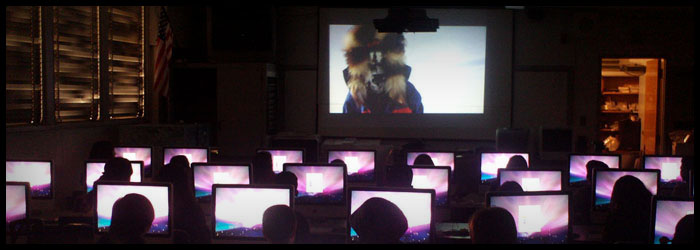

Individual resilience is a person's ability to cope with adversity. Resilience is also related to how a nation is capable of coping with adversity such as economic volatility and climate change.
Both individual resilience and a nation's economic resiliency are stressed by poverty and income inequality. Some individuals demonstrate resiliency in addressing poverty in their community or personal circumstances by starting their own micro-enterprises or becoming social entrepreneurs. Nations strengthen economic resilience by promoting the social conditions that empower individuals to be able to break inter-generational cycles of poverty.
Learning outcomes
Through exploring the concepts in two case studies and a class project, students will learn:
- What is individual resiliency?
- Why is individual resiliency important?
- What are the students' own personal qualities and aspects of the world around them that help them be resilient?
- What might individual resiliency look like in a developing country?
- What are ways that people and communities show resiliency in developing countries?
- What helps people and communities to be resilient both at home and in developing countries?
- In what ways is individual resiliency related to being an entrepreneur, both at home and in a developing country?
- What are the ways that the students' own personal qualities of resiliency enable them to be a leader or entrepreneur?
Outline
- Class Plan 1 Concept: Resilience as "Ordinary Magic"
- Class Plan 2 Concept: "A resilient fighter", Resiliency and Social Entrepreneurship in Africa
- Class Plan 3 Reflection: What is my personal "Ordinary Magic" to become a social entrepreneur?
Class Plan 1 Concept: Resilience as "Ordinary Magic"
What is individual resiliency?
According to Ann Masten, a research psychologist, resilience "refers to a class of phenomena characterized by good outcomes in spite of serious threats to adaptation or development." (March 2001, Ordinary Magic: Resilience Processes in Development, American Psychologist, p.228)
In other words, resilience is when a person is able to cope and succeed in the face of experiencing adversity.
Discussion: Many movies have stories of a hero or heroine who overcomes threats or adversity by showing resilience or the ability to cope and succeed. What are some of the movies that come to mind that have a story about a resilient hero or heroine? What happened in the story? What do you think are the qualities that helped the hero or heroine to overcome challenges in the story?
Why is individual resiliency important?
As a research psychologist, Ann Masten studies what promotes resiliency in people. She found that resiliency is "ordinary magic", that the ability to cope with severe adversity is a basic and common to how human's adapt.
This is important because if resiliency is "ordinary magic" as described by Masten, then being resilient can be a basic and common quality that we have ourselves, and it is a basic and common quality that people have in our families, schools, communities, countries, and around the world.
Reflection: Resilience in the people around us
Exercise: We see the "ordinary magic" of resilience within ourselves and around us. Think of a person whom you admire who is resilient and has overcome challenges. This person can be a family member, someone at your school, or someone whom you wish you could meet.
Imagine that you were a movie director and wanted to tell this person's story through a movie that shows: (1) how this person is resilient, (2) what challenges they faced, and (3) how they overcame the challenges.
To plan how to tell a story in a film, film makers do a "story board" that looks like a comic book, with pictures and notes that show the different parts of how the film might be shot and told. Draw and write a story board of how you would tell this person's story.
Class Plan 2 Concept: "A resilient fighter", Resiliency and Social Entrepreneurship in Africa
- What might individual resiliency look like in a developing country?
- What are ways that people and communities show resiliency in developing countries?
Like the story board that you created about a person who inspired you with their resiliency, many film makers have made documentaries about people whose resiliency inspired others to work toward a common goal. Lisa Merton and Alan Dater are film-makers who were inspired to make a documentary called "Taking Root: The Vision of Wangari Maathai".
Wangari Maathai won the Nobel Peace Prize in 2004 for her work in Kenya to inspire women to plant trees.
Trees are an essential part of a sustainable economy by preventing soil erosion essential to agriculture and access to clean water. Deforestation had an inequitable impact on poor communities that depend upon farming, so planting trees helped to fight poverty. Wangari Maathai believed that a healthy environment supported a stronger economy, and a more equal and peaceful society.
Discussion: The short from the documentary "Taking Root: The Vision of Wangari Maathai" is posted at:
http://www.greenbeltmovement.org/wangari-maathai/taking-root-documentary
As you watch the documentary, make a list of what made Wangari Maathai a "resilient fighter": (1) how she was resilient, (2) what challenges she faced, and (3) how she overcame the challenges.
What are the parts of her story that might be unique to being in Kenya? What are the parts of her story that might be similar to other people's stories of overcoming severe adversity in North America?
Reflection: Turning Resilience into Action
- In what ways is individual resiliency related to being an entrepreneur, both at home and in a developing country?
Wangari Maathai improved the living conditions of many people by helping whole communities become resilient to economic and environmental hardship through creating an organization called the Green Belt Movement.
In this respect, she was a social entrepreneur by creating an organization that recruited hundreds of thousands of people to plant over 40 million trees. Social entrepreneurs come up with large-scale innovative solutions to social problems. Sometimes the large scale innovative solutions involve many individuals involved in micro-enterprises or small companies, such as the many individuals across Africa who worked in co-operative groups to plant trees.
Exercise: Go back to your story board for a film about someone whom you admire and demonstrated the "ordinary magic" of resiliency. If you were to create a social enterprise that worked to "get to the root causes" of the adversity that they faced and to change other people's lives for the better, what would that organization or micro-enterprise look like and what would it do? Story board a "Part Two" sequel to your film that imagines how you would start up the social enterprise because of how inspired you were by this person's story.
Class Plan 3 Reflection: What is my personal "Ordinary Magic" to become a social entrepreneur?
- What are the ways that the students' own personal qualities of resiliency enable them to be a leader or entrepreneur?
We learned earlier about how resiliency is akin to "ordinary magic" in that it is a common and basic ability that people have to adapt to severe adversity. While we rightfully admire people like Nobel Peace laureate Wangari Maathai who exhibit extraordinary resilience, we have the same potential to demonstrate resilience to pursue extraordinary entrepreneurship in our lives and in working with others toward a common social and economic goal.
In your story board, you told a story about how you would start up a social enterprise that would address an issue or problem that is important to you or important in the life of someone whom you admire. What are your strong qualities and abilities, and qualities or abilities that you would like to further develop, that would make it possible for you to create that social enterprise? For example, you might list that you are creative in solving problems, and identify that you need to learn how to better cope with stressful situations.
Group project: Starting up a social enterprise
Split into groups of three to five. Each person will have 5 minutes to present their story board to their group, and to share their list of their abilities and qualities that contribute to their being resilient.
After every member of the group has presented, discuss as a group the following questions, with one person agreeing to be note-taker and one to be presenter:
- Were there common themes or very different challenges presented in each of the stories?
- Were there very different social enterprises conceived of in each story, or were there some common themes?
- Working as a team to start up one of the social enterprises, how would you work well with each other by building on each other's strengths and complementing each person's abilities?
- What is one social enterprise that the group agrees would be an effective way of addressing a social or economic issue or problem?
- How would the team see themselves working together to create the social enterprise? What ideas do team members have on how they would start up the social enterprise?
Each group presenter will present to the class about the social enterprise that their group has envisioned, and how they would bring that vision to life.









